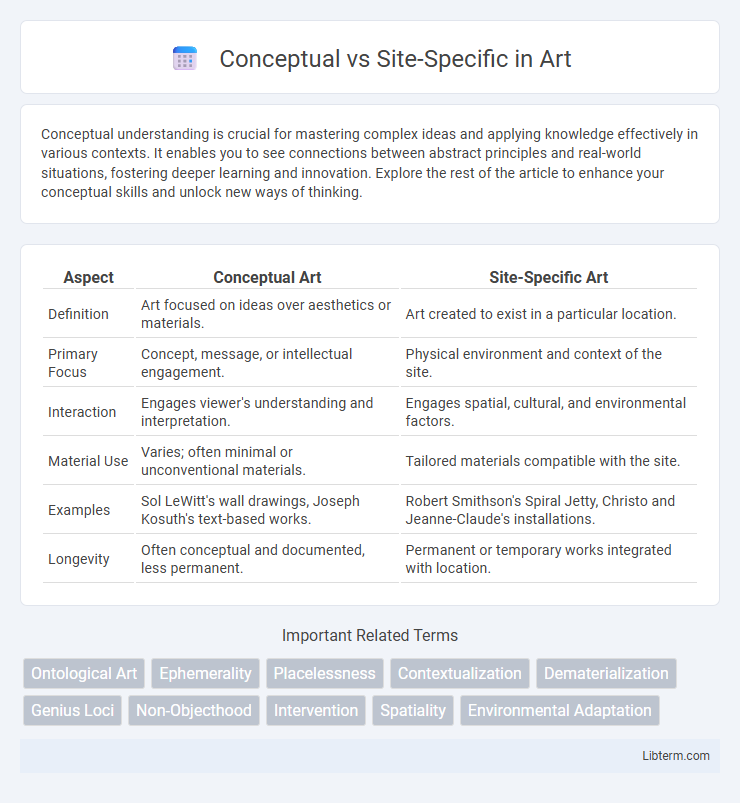Conceptual understanding is crucial for mastering complex ideas and applying knowledge effectively in various contexts. It enables you to see connections between abstract principles and real-world situations, fostering deeper learning and innovation. Explore the rest of the article to enhance your conceptual skills and unlock new ways of thinking.
Table of Comparison
| Aspect | Conceptual Art | Site-Specific Art |
|---|---|---|
| Definition | Art focused on ideas over aesthetics or materials. | Art created to exist in a particular location. |
| Primary Focus | Concept, message, or intellectual engagement. | Physical environment and context of the site. |
| Interaction | Engages viewer's understanding and interpretation. | Engages spatial, cultural, and environmental factors. |
| Material Use | Varies; often minimal or unconventional materials. | Tailored materials compatible with the site. |
| Examples | Sol LeWitt's wall drawings, Joseph Kosuth's text-based works. | Robert Smithson's Spiral Jetty, Christo and Jeanne-Claude's installations. |
| Longevity | Often conceptual and documented, less permanent. | Permanent or temporary works integrated with location. |
Introduction to Conceptual and Site-Specific Approaches
Conceptual and site-specific approaches differ primarily in their relation to context and meaning within artistic or design practices. Conceptual approaches emphasize abstract ideas, prioritizing intellectual engagement over physical or cultural environment, while site-specific approaches focus on creating works that interact with or respond directly to a particular location, integrating environmental, historical, and social factors. Understanding these distinctions is crucial for practitioners aiming to balance theoretical intent with tangible spatial dynamics in their projects.
Defining Conceptual Art and Practice
Conceptual art emphasizes ideas and concepts over traditional aesthetic and material concerns, often challenging the conventional boundaries of art by prioritizing intellectual engagement. This practice involves using language, documentation, and performance to convey meaning, making the concept the central element rather than the physical artwork itself. Conceptual artists such as Sol LeWitt and Joseph Kosuth focus on the process of thought and context, contrasting with site-specific art which relies on the physical location for its significance.
Understanding Site-Specific Art and Projects
Site-specific art is created to interact with and reflect a particular location's environment, history, and social context, differentiating it from conceptual art which prioritizes ideas over physical placement. These projects engage deeply with the site's unique characteristics, transforming space into an integral part of the artwork's meaning and experience. Understanding site-specific art requires recognizing its dependence on geographical, cultural, and architectural elements that cannot be separated from the piece itself.
Historical Evolution of Both Concepts
Conceptual art, emerging prominently in the 1960s and 1970s, emphasizes ideas over traditional aesthetic and material concerns, revolutionizing the art world by challenging conventional definitions of art. Site-specific art evolved from land art and environmental art movements, gaining momentum in the 1960s, and centers on creating works that are intrinsically connected to and shaped by the unique characteristics of their locations. The historical evolution of both concepts reflects a shift from object-based art to experience and context-driven creations, highlighting changing perceptions of space, meaning, and artistic intention.
Key Differences Between Conceptual and Site-Specific Works
Conceptual works prioritize ideas and processes over physical form, emphasizing intangible concepts that can exist independently of a particular location. Site-specific works are created in response to or integrated with a particular environment, making the location an essential component of the artwork's meaning and experience. The key difference lies in conceptual art's detachment from place, whereas site-specific art derives significance directly from its interaction with the site.
Influential Artists and Notable Examples
Conceptual art pioneers like Sol LeWitt emphasized ideas over aesthetics, with works such as "Wall Drawing #1096" showcasing the power of instructions as art. Site-specific art, exemplified by Christo and Jeanne-Claude's "The Gates" in Central Park, transforms environments by creating immersive experiences tied directly to location. Both approaches redefine traditional art forms, influencing contemporary artists to explore context and concept as integral components of their creations.
Methods and Processes in Each Approach
Conceptual art methods emphasize idea generation and intellectual engagement, often using sketches, models, and written instructions to express abstract concepts. Site-specific art processes involve detailed site analysis, spatial planning, and material selection tailored to the physical location, integrating environmental and cultural context into the artwork. Techniques in conceptual art prioritize narrative and symbolism, while site-specific approaches focus on interaction with architecture, landscape, and audience dynamics.
The Role of Context and Audience
Conceptual art prioritizes abstract ideas and theoretical frameworks, often independent of the physical location, allowing for universal interpretation across diverse audiences. Site-specific art integrates its meaning closely with the physical environment and cultural context, creating a dialogue that resonates uniquely with local viewers. Understanding the role of context and audience enhances the appreciation of how meaning shifts between universal concepts and localized experiences in these art forms.
Challenges and Critiques Faced by Both
Conceptual art often faces challenges related to its intangible nature, making it difficult for audiences to engage or interpret without prior knowledge, while critics argue it sometimes lacks aesthetic appeal. Site-specific art encounters practical issues such as environmental impact, preservation difficulties, and potential conflicts with the site's original context, prompting debates over authenticity and permanence. Both forms are critiqued for accessibility, with conceptual work perceived as elitist and site-specific pieces sometimes criticized for limited audience reach.
Conclusion: Choosing Between Conceptual and Site-Specific
Selecting between conceptual and site-specific design depends on project goals, site conditions, and desired user experience. Conceptual designs offer flexibility and broad applicability, ideal for innovative ideas or multiple locations. Site-specific approaches prioritize environmental integration and local context, enhancing relevance and resonance with the immediate surroundings.
Conceptual Infographic

 libterm.com
libterm.com